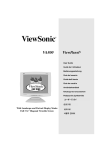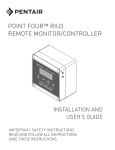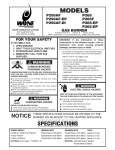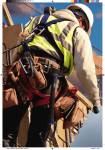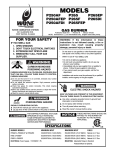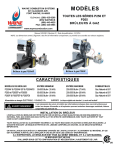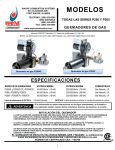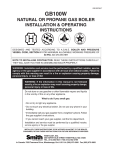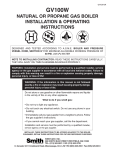Download Wayne P265F Instruction manual
Transcript
342 N. Co. Rd. 400 East Valparaiso, IN 46383 219-464-8818 • Fax 219-462-7985 www.heatwagon.com Installation and Maintenance Manual Please retain this manual for future reference. VG175 Construction Heater C Revision 1-06 US For your safety: Do not use this heater in a space where gasoline or other liquids having flammable vapors are stored. IMPORTANT INFORMATION! READ FIRST The heater is designed for use as a construction heater under ANSI Z83.7a-2000. The primary purpose of construction heaters is to provide temporary heating of buildings under construction, alteration, or repair and to provide emergency heat. Properly used, the heater provides safe, economical heating. Products of combustion are vented outside the area being heated. The heater IS NOT designed as an Unvented Gas Fired Room Heater under ANSI-Z21.11.2 and SHOULD NOT be used in the home. ANSI A119.2(NFPA 501C)-1987 Recreational Vehicle Standard prohibits the installation or storage of LP-gas containers even temporarily inside any recreational vehicle. The standard also prohibits the use of Unvented Heaters in such vehicles. NFPA-58 1989 STANDARD FOR THE STORAGE AND HANDLING OF LIQUEFIED PETROLEUM GASES Use of the heater must be in accordance with this Standard and in compliance with all governing state and local codes. Storage and handling of propane gas and propane cylinders must be in accordance with NFPA 58 and all local governing codes. We cannot anticipate every use which may be made for our heaters. CHECK WITH YOUR LOCAL FIRE SAFETY AUTHORITY IF YOU HAVE QUESTIONS ABOUT LOCAL REGULATIONS. Other standards govern the use of fuel gases and heat producing products in specific applications. Your local authority can advise you about these. FOR YOUR SAFETY DO NOT USE THIS HEATER IN A SPACE WHERE GASOLINE OR OTHER LIQUIDS HAVING FLAMMABLE VAPORS ARE STORED OR USED. CONSTRUCTION HEATER GENERAL HAZARD WARNING: Failure to comply with the precautions and instructions provided with this heater can result in death, serious bodily injury and property loss or damage from the hazards of fire, explosion, burn, asphyxiation, carbon monoxide poisoning, and/or electrical shock. Only persons who can understand and follow the instructions should use or service this heater. If you need assistance or heater information such as an instruction manual, labels, etc., contact your local Heat Wagon dealer or the manufacturer. W A R N I N G Fire, burn, inhalation, and explosion hazard. Keep solid combustibles, such as building materials, paper or cardboard, a safe distance away from the heater as recommended by the instructions. Never use the heater in spaces which do or may contain volatile or airborne combustibles, or products such as gasoline, solvents, paint thinner, dust particles or unknown chemicals. Not for home or recreational vehicle use! If you have read this entire manual and you still have questions, please call us at 219-464-8818 Installation and Maintenance Manual Model VG175 Construction Heater Table of Contents: Page Safety & Caution . . . . . . . . . . . . . . . . . . . . . . . . . . . . . . . . . . . . . . . . . . . .4 Specifications . . . . . . . . . . . . . . . . . . . . . . . . . . . . . . . . . . . . . . . . . . . . . . .4 Operating Instructions . . . . . . . . . . . . . . . . . . . . . . . . . . . . . . . . . . . . . . . .5 Maintenance . . . . . . . . . . . . . . . . . . . . . . . . . . . . . . . . . . . . . . . . . . . . . . . .8 Troubleshooting . . . . . . . . . . . . . . . . . . . . . . . . . . . . . . . . . . . . . . . . . . . .10 Illustrated Parts Breakdown . . . . . . . . . . . . . . . . . . . . . . . . . . . . . . . . . . .15 Wiring Diagrams . . . . . . . . . . . . . . . . . . . . . . . . . . . . . . . . . . . . . . . . . . .17 Exhaust Flue Pipe Guidelines . . . . . . . . . . . . . . . . . . . . . . . . . . . . . . . . .19 WARRANTY This heater is guaranteed against defective materials and workmanship for one (1) year from Heat Wagon invoice date. Warranty repairs may be made only by an authorized, trained and certified Heat Wagon dealer. Warranty repairs by other entities will not be considered. Warranty claims must include model number and serial number. Components are guaranteed to the extent of the component manufacturer’s warranty. LIMITATIONS Warranty claims for service parts (wear parts) such as spark plugs, igniters, and flame rods will not be allowed. Diagnostic parts such as voltage meters and pressure gauges are not warrantable. Evidence of improper fuel usage, fuel pressures outside of manufacturer’s specification, poor fuel quality, improper electric power, misapplication and/or evidence of abuse may be cause for rejection of warranty claims. Labor, travel time, mileage and shipping charges will not be allowed. Minor adjustments to heaters are the responsibility of the dealer. Defective parts must be tagged and held for possible return to the factory for 60 days from date of repair. The factory will provide a return goods authorization, (RGA) for defective parts to be returned. No warranty will be allowed for parts not purchased from Heat Wagon. 342 N. Co. Rd. 400 East • Valparaiso, IN 46383 219-464-8818 • 888-432-8924 • Fax 800-255-7985 www.heatwagon.com SAFETY & CAUTION • Instructions given in this manual and the applicable regulations of the local authorities must be followed. • The unit may be operated only by those persons who have been instructed in its proper use. • The unit is to be installed and operated in such a way as to ensure the safety of employees and surroundings. • Never cover the unit’s air openings. • Always ensure adequate fresh air supply to the unit. • Never stand in front of the discharge end of the heater. • Keep a minimum clearance of 10 feet from the fuel source. Storing and use of liquid fuel must comply with the regulations and instructions given by the local authorities. • Unit’s emitted noise level at the range of 3 feet: 74 dBA. • Do not introduce foreign objects into the unit. • Do not expose the unit to direct water jets. • All electric cables outside the unit are to be protected against damage. • Always disconnect the unit from power supply and turn off the gas supply when maintenance or service is being performed. • IF NOT OPERATED WITHIN GUIDELINES OF THESE OPERATING INSTRUCTIONS, MANUFACTURER WILL NOT BE HELD RESPONSIBLE AND WARRANTY WILL BECOME VOID. SPECIFICATIONS Model No. VG175 Fuels: Capacity: Blower: Electrical Rating: Fuel Consumption: Remote Thermostat: Max. Discharge Temp.: Duct Size: Weight (approximate): Gas Supply: Vapor Propane or Natural Gas 175,000 BTU/HR* 1,400 CFM 1/2” SP 120 Volts, 10 Amps NG-175 CFH / Propane-1.9 GPH On/Off 200ºF @ 0ºF Ambient 8” Dia., 25 ft. max (straight), temp rating 300ºF min. 186 lbs. Inlet Pressure Max W.C. Min W.C. Vapor Propane 14 W.C. 9” W.C. Natural Gas 14 W.C. 9” W.C. Manifold Pressure W.C. 3” 3.2” Burner Orifice .201 .261 *Note: Overfiring this heater above 195,500 BTU(Nat. Gas) or 184,000 BTU(Propane) will result in inefficient combustion. In order to avoid this possibility the factory standard input rates are adjusted 15% below these ratings. 4 OPERATING INSTRUCTIONS INSTALLATION • When transporting, use both lifting eyes located on sides of heater. • Place the unit on a level and non-combustible surface. • Minimum clearances from combustibles: - outlet, minimum 10 feet - sides, minimum 3 feet - top, minimum 3 feet - flue pipe exhaust, gas discharge minimum 2 feet • Manufacturer recommends a free zone of 5 feet around the unit and a minimum distance of 10 feet at the unit’s flue gas openings are to be maintained. • If the unit is placed indoors, secure an adequate fresh air opening for the burner combustion air. • The unit may not be installed and operated in premises where explosive or combustible fumes or dust are present. Always check the regulations of local authorities. • Be certain that neither the air inlet nor the air outlet is obstructed. FUEL SUPPLY • This heater is shipped as either natural gas or vapor propane. Check for proper burner orifice in burner. Natural Gas .261 PN 62182 Vapor Propane .201 PN 62371-020 • Be certain to use adequate hose or pipe size to ensure proper volume and pressure. See Chart Below. NATURAL GAS QUICK REFERENCE HOSE CHART Hose Length in Feet 10 25 35 50 75 100 125 150 175 200 225 BTU 175,000 <1PSI 2PSI 5PSI 3/4 3/4 3/4 3/4 3/4 3/4 1-1/4 3/4 1-1/4 3/4 1-1/4 3/4 1-1/4 3/4 1-1/4 3/4 1-1/4 3/4 1-1/4 3/4 1-1/4 3/4 - VAPOR PROPANE QUICK REFERENCE HOSE CHART Hose Length in Feet 10 25 35 50 75 100 125 150 175 200 225 BTU 175,000 1/2PSI 10PSI 3/4 3/4 3/4 3/4 3/4 3/4 3/4 3/4 3/4 3/4 1-1/4 3/4 1-1/4 3/4 1-1/4 3/4 1-1/4 3/4 1-1/4 3/4 1-1/4 3/4 For supply pressures greater than 1/2psi • A regulator must be installed on the heater to ensure that the pressure to the heater does not exceed 1/2 psi inlet pressure. Excessive pressures over 1/2 psi (14” W.C.) will damage controls and void warranty. 5 FUEL SUPPLY (CONTINUED) • Ensure that for the surrounding temperature, size and capacity of the propane supply cylinder is adequate to provide the rated Btu/hr input to the heater. • Visually inspect the hose assembly and ensure that it is protected from traffic, building materials, and contact with hot surfaces. If it is evident that there is excessive abrasion or wear, or the hose is cut, replace it immediately. • Purge air from line and wait 10 minutes for gas to dissipate. • After installation, check the hose assembly for gas leaks by applying a water and soap solution to each connection. • Fuel hose must be UL approved. • The installation of this heater to a natural gas supply must confirm with all applicable local codes or, in the absence of local codes, with the National Fuel Gas Code ANSI Z223.1/NFPA 54. For vapor propane, refer to standard for Storage and Handling of Liquified Petroleum Gases ANSI/NFPA 58. ELECTRICAL • Electric cable extensions must be connected based on the unit capacity and cable length. • Confirm voltage at heater connection (105V min.) to ensure proper operation. EXHAUST FLUE PIPE • The unit is to be connected to a flue pipe with adequate draft, to ensure the proper start and operation of the unit. Refer to page 19. • The flue pipe is to be made of non-combustible material and clearances from combustible materials must be a minimum 8 inches (temperature of flue gases is approximately 410º F). • The flue pipe and its installation must comply with the regulations and instructions given by the local authorities. START UP • Only people trained in the operation and supervision of this heater should operate and maintain the unit. • Check the unit to make sure that there are no visible defects on the control and safety devices and that the unit has been installed correctly. 1. Check that the control switch on the control box is in position “0” (STOP). 2. Pre-select desired room temperature on the room thermostat. The temperature must be set higher than the ambient temperature. 3. Open all possible shut-off devices of the fuel supply lines. 6 START UP (CONTINUED) 4. Turn the control switch on the control box to position “1” (HEATING). 5. When the ambient temperature level is low, the burner switches on automatically. The fan does not switch on until the set temperature (104ºF) of the heat-exchanger has been reached (will take approximately 1-5 minutes). • After startup, the heater is operated automatically by the room thermostat and governed by all control devices, including the safety limit controls. • The room thermostat (TSTAT) and burner sensor control the running sequences of the burner and the fan sensor controls the fan function. • Overheat limit reset (STB) controls and shuts off the heater (burner) in the case of overheating. • The unit can also be used for ventilation purposes only, if needed. 1. Turn the control switch on the control box to position “2” (VENTILATION). 2. The unit is now in the continuous ventilating mode. 3. Heating is not possible in this mode. DUCTING (Warm Air) • Minimum clearance from combustible materials is 4 inches. • Use steel ducting or fabric ducting capable of withstanding maximum temperature of 300ºF. • Maximum length of duct: 25’ (straight). • Duct diameter: 8”. • Make sure that the duct is safely and properly fastened to the outlet. • Avoid sharp bends and corners to ensure maximum air flow and avoid back pressure/heat accumulation in heater. • FAILURE TO COMPLY WITH THESE RECOMMENDATIONS COULD RESULT IN SHUTDOWN OF THE HEATER. SHUT DOWN • Turn control switch to position “0” (STOP). • Close fuel supply. Important! The air supply fan continues running to cool down the combustion chamber/heat exchanger and then stops later. The fan can restart for several times before finally switching off! WARNING! UNIT MAY BE UNPLUGGED IN EMERGENCY SITUATIONS ONLY. OTHERWISE, DO NOT STOP THE UNIT BY UNPLUGGING IT. UNIT NEEDS TO COOL DOWN USING ITS OWN FAN. FAILURE TO COMPLY WITH PROPER SHUT-DOWN PROCEDURES CAN CAUSE DAMAGE TO THE COMBUSTION CHAMBER, HEAT EXCHANGER, SAFETY FEATURES AND VOID WARRANTY. 7 MAINTENANCE Prior to starting any maintenance work be sure to disconnect unit from power supply until unit cools down fully and fan shuts off! (Shut Down Procedures page 7) To ensure the proper function of the unit, it must be serviced on regular basis. Maintenance can be performed, excluding the control devices and safety limit controls, by an authorized trained & certified Heat Wagon dealer. The control devices and safety limit controls do not need routine maintenance. If these items fail they must be replaced. - Do not use any aggressive cleaning agents, which are harmful or environmentally unfriendly, when cleaning the unit. - Do not use water jet when cleaning the unit. - Pressurized air may be used for maintenance. Be careful not to damage the fan blower wheel with too much pressure. - Check whether the unit is free from mechanical damage, replace faulty parts as necessary. - Check fan blower wheel of the fan at regular intervals and clean it when needed. - Check functionality of control and safety devices regularly. - Have the flue gas values of the burner checked regularly by authorized agents. - Be sure to store the unit in a dust free and dry place when it is not used for a long period of time. Cover the exhaust flue to prevent entry of foreign objects. 8 SERVICE • The complete unit, including heat exchanger, combustion chamber and burner should be cleaned from dust and dirt after every heating period, at a minimum of once per year. -Removal of combustion chamber/heat exchanger: For proper cleaning of the unit, manufacturer recommends removal of the complete combustion chamber with heat exchanger. Clean combustion chamber and exchanger tube with brush. Vacuum all loose ash and soot. Close all cleaning flanges carefully to avoid damage to gasket material. -Disassembling of burner: 1. Disassemble four tightening bolts on the combustion chamber flange and remove burner’s mounting flange. Take care not to damage the flange seal. 2. Pull out the burner. Take care not to damage the burner head and power cable. Clean blower wheel, ignitor electrode, and flamerod. Refer to seperate burner manual for adjustment of burner. 9 10 2. The heater runs for a little while, but shuts down. It won’t come on again until I reset the limit switch. 1. Turn the heater to position #1 and nothing happens. • Overheat limit switch faulty due to loss of power • Restricted airflow • Incorrect burner manifold pressure • Burner orifice is improperly sized • Heater control unit (HCU) • Burner sensor • Burner motor relay • 24 volt transformer • Power supply cord • Burner lock out on the burner flame safeguard control box is engaged • Overheat limit switch is tripped VG175 TROUBLESHOOTING Symptom Possible Causes • For propane, use size .201. For natural gas, use size .261. • Use a low pressure gauge (0-15 inches of water column) with a 1/8” NPT inlet. Install gauge in the pressure tap port located on the output side of the gas valve. Run the heater. Adjust the pressure by turning the pressure adjusting screw (located on the input side top of the gas valve) counter clockwise until the gauge reads 3” W.C.(Propane) & 3.2”W.C.(Nat Gas) • Check for dirt or ice buildup on the air inlet or blower wheel. If using duct on the air outlet, insure the back pressure does not exceed a static pressure of .25” W.C. Check with low pressure gauge if necessary (0-15 inches of water column). • Adhere to the proper shut down procedures. Power must remain at the unit until it cools down fully. Blower will shut down on its own when cool. Test overheat limit switch for continuity between the two male terminals at room temperature. Replace if overheat limit switch fails test. • Reset switch, located on the right hand corner (facing the right hand side of the unit) . • Using a volt meter, check for 24 volts AC between ground and one of the “T” terminals on the burner control box. If less than 24 replace transformer. • Turn on the heater. Check for 120 volts between ground and both black wires on the relay. Relay is located in the burner control box under the flame safeguard control. If less than 105 replace relay. • On the heater control unit (HCU) disconnect the wires from terminals X10 and X11. Using an ohm meter, check the resistance between the two wires for a reading of 8K-15K ohms. Replace sensor if out of range. • On the main terminal block, check for 120 volts between terminals 8 and N when the 3-position switch is in the HEAT position. If less than 105 replace HCU. • Test for 120 volts between L1 and N on the main terminal block. • Turn thermostat off and on. Possible Solutions 11 4. Burner motor comes on, but the heater won’t ignite. 3. The heater has a loud rumbling sound. • Rough setting at 4.5. Minor adjustments from the rough settings can be made to achieve a smooth sounding burner with no soot from the flue pipe. • Clean with fine sandpaper. Make sure it is free from buildup or cracks. • Turn off the gas valve, turn on the burner. Use insulated pliers to hold the ignition wire and short it to ground. Pull the wire away from ground slowly. A rainbow colored arc should travel between the wire and the ground at a distance of 3/8 of an inch for a duration of 4-5 seconds. • Air inlet damper adjustment • Ignition electrode • Electronic igniter • Use a low pressure gauge (0-15 inches of water column) with 1/8” NPT inlet. Install gauge in the pressure tap port located on the output side of the gas valve. Run the heater. Adjust the pressure by turning the pressure adjusting screw (located on the input side top of the gas valve) counter clockwise until the gauge reads 3” W.C.(Propane) & 3.2”W.C.(Nat Gas). Refer to pipe sizing charts in the Heat Wagon Engineering Guide. Heater requires 9-14” W.C. inlet pressure. • For propane, use size .201. For natural gas, use size .261. • Remove flue pipe and use a flashlight to inspect the inside of the heat exchanger. The access panel is located in the front panel which is welded to the flue pipe. Clean the inside of the heat exchanger. • Use a low pressure gauge (0-15 inches of water column) with 1/8” NPT inlet. Install gauge in the pressure tap port located on the output side of the gas valve. Run the heater. Adjust the pressure by turning the pressure adjusting screw (located on the input side top of the gas valve) counter clockwise until the gauge reads 3” W.C.(Propane) & 3.2”W.C.(Nat Gas). Refer to pipe sizing charts in the Heat Wagon Engineering guide, Heater requires 9-14” W.C. inlet pressure. Ensure proper purge procedure (see fuel supply installation). • Rough setting at 6. Minor adjustments from the rough settings can be made to achieve a smooth sounding burner with no soot from the flue pipe. • Clean the burner blower wheel with a small brush. • Refer to the flue pipe chart in this manual. Check flue for restriction. Possible Solutions • Fuel pressure or volume • Restrict heat exchanger • Burner orifice size • Dirt on burner blower wheel • Flue pipe setup or flue pipe restrictions • Gas manifold pressure • Air damper setting VG175 TROUBLESHOOTING Symptom Possible Causes 12 • Clean the burner blower wheel with a small brush. • Refer to the flue pipe chart in this manual. Check flue for restriction. • Dirt on burner blower wheel • Improper flue pipe setup or flue pipe restrictions • Gas manifold pressure • For propane, use size .201. For natural gas, use size .261. • Remove flue pipe and use a flashlight to inspect the inside of the heat exchanger. The access panel is located in the front panel which is welded to the flue pipe. • Incorrect burner orifice size • Restricted heat exchanger • Use a low pressure gauge (0-15 inches of water column) with 1/8” NPT inlet. Install gauge in the pressure tap port located on the output side of the gas valve. Run the heater. Adjust the pressure by turning the pressure adjusting screw (located on the input side top of the gas valve) counter clockwise until the gauge reads 3” W.C.(Propane) & 3.2” W.C.(Nat Gas). Refer to pipe sizing charts in the Heat Wagon Engineering Guide. Heater requires 9-14” W.C. inlet pressure. • Rough setting at 4.5. Minor adjustments from the rough settings can be made to achieve a smooth sounding burner with no soot from the flue pipe. • Air damper setting 5. The heater blows black smoke out of the vent stack. • If there is power at the flame safeguard control and no power out to the solenoid valve, replace the flame safeguard control. Check for continuity between the terminals on the solenoid valve coil. • Gas valve Possible Solutions 4. Continued VG175 TROUBLESHOOTING Symptom Possible Causes 13 7. The burner starts, but the main fan never comes on. 6. The burner seems to cycle on and off more than it should. • Blower motor • Current overload on blower motor • Blower motor relay • Heater Control Unit (HCU) • Fan sensor • Heater Control Unit (HCU) • On the heater control unit (HCU) disconnect the wires from terminals X12 and X13. Using an ohm meter, check the resistance between the two wires for a reading of 8K-15K ohms. • Turn the 3-position main switch to the fan position. If the blower runs, check the fan sensor. If it is good, replace the HCU. • Turn the 3-position main switch to the fan position. If the relay pulls in, check for voltage between the L1 and L2 terminals. Then check the voltage between terminals T1 and T2. The voltage should be the same. If it is much lower, replace the relay. • Turn the 3-position main switch to the fan position. Check for voltage between the 2 solenoid coil terminals on the relay. If there is no voltage, the overload is bad. Replace the motor and blower assembly. • Turn the 3-position main switch to the fan position. Check for voltage between terminals T1 and T2 on the motor relay. If the voltage is good, replace the motor and blower assembly. • Check for dirt or ice buildup on the air inlet or blower wheel. If using duct on the air outlet, insure the back pressure does not exceed a static pressure of .25” W.C. Check with low pressure gauge (0-15 inches of water column). • On the heater control unit (HCU) disconnect the wires from terminals X10 and X11. Using an ohm meter, check the resistance between the two wires for a reading of 8K-15K ohms. Replace sensor if reading is out of range. • If all of the above check good, replace the HCU. • Dirt on main air blower or improper setup of outlet air duct • Burner sensor • Use a low pressure gauge (0-15 inches of water column) with 1/8” NPT inlet. Install gauge in the pressure tap port located on the output side of the gas valve. Run the heater. Adjust the pressure by turning the pressure adjusting screw (located on the input side top of the gas valve) until the gauge reads 3” W.C.(Propane) & 3.2” W.C.(Nat Gas). Refer to pipe sizing charts in the Heat Wagon Engineering Guide. Heater requires 9-14” W.C. inlet pressure. Possible Solutions • Gas manifold pressure VG175 TROUBLESHOOTING Possible Causes Symptom 14 8. The burner continues to run, but the fan cycles on and off. • Use a low pressure gauge (0-15 inches of water column) with 1/8” NPT inlet. Install gauge in the pressure tap port located on the output side of the gas valve. Run the heater. Adjust the pressure by turning the pressure adjusting screw (located on the input side top of the gas valve) until the gauge reads 3” W.C.(Propane) & 3.2” W.C.(Nat Gas). Refer to pipe sizing charts in the Heat Wagon Engineering Guide. Heater requires 9-14” W.C. inlet pressure. • Refer to pipe sizing charts in the Heat Wagon Engineering Guide. Heater requires 9-14” W.C. inlet pressure. • On the heater control unit (HCU) disconnect the wires from terminals X12 and X13. Using an ohm meter, check the resistance between the two wires for a reading of 8K-15K ohms. If the test falls out of this range, replace fan sensor. • Turn the 3-position main switch to the fan position. If the blower runs, check the fan sensor. If it is good, replace the HCU. • Fuel supply pressure and volume • Fan sensor • Heater Control Unit (HCU) Possible Solutions • Gas manifold pressure VG175 TROUBLESHOOTING Possible Causes Symptom Heat Wagon VG175 Parts List ITEM 1 2 3 4 5 6 7 8 9 11 12 13 15 16 22 23 PART# HWP 2709001 HWP 2709002 HWP 2709003 HWP 2709004 HWP 2709005 HWP 120001 HWP 2701065 HWP 2709008 HWP 2709009 HWP 2709011 HWP 2701244 HWP 40900 HWP 63956 HWP 2709016 HWP 41000 HWP 1709023 DESCRIPTION HEATER FRAME COVER PLATE SIDE PANELS (2) REAR HANDLE BOTTOM PLATE FLUE COLLAR WHEEL WHEEL SHAFT BURNER CHAMBER ASSEMBLY FAN GUARD, RIGHT FAN, COMPLETE FAN CONNECTION BOX BURNER VG175 BURNER COVER MAIN CONTROL BOX BRACKET, MAIN CONTROL BOX ITEM 24 25 26 27 28 29 30 PART# HWP 26400 HWP 21400 HWP 40850 HWP 20579 HWP 20581 HWP 20582 HWP HC1020 DESCRIPTION MAIN SWITCH OVERHEAT LIMIT SWITCH (Capillary) THERMOSTAT BOX HEATER CONTROL UNIT FAN SENSOR (FOR POS. #27) BURNER SENSOR (POS. #27) POWER CORD & PLUG NOT SHOWN IN DIAGRAM HWP 2709031 RADIATION SHIELD (UPPER) HWP 12000 SMOKE FLUE W/RAIN CAP HWP 2453 REMOTE THERMOSTAT HWP 2700428 GASKET FOR BURNER MOUNT HWP 2704085 SILICONE SEAL - 40850 THERM. BOX HWP 40SV06 OPTIONAL REGULATOR FOR MORE THAN 14” W.C. HWP 210047 RUBBER EDGE SEAL (SOLD PER FOOT) (30 FEET PER HEATER) Also see Control Box Parts page 17. 15 WAYNE BURNER PARTS BREAKDOWN ITEM 1 2 3 4 5 6 7 8 9 10 11 12 13 14 15 16 17 18 19 20 21 22 23 24 16 PART# 62700-002 16635-002 63244-002 60226 12697-002 100603-008 61624-002 101243-001 63674-001 60177 61755 62899 44 62960-001 62360 15731 63256-001 61843 62374-004 61759 100603-001 62658-001 61684 61830 DESCRIPTION Bracket, Control Mounting Washer, Flat #8 Screw, Fillester 10-24 x .250 Bushing, Metal Screw, HXSL 23 10-24 x .375 Screw, HXSL 8 18 x 1.25 Nipple - 3/4” x 4” TBE Blk Control, Ignition Elbow, 3/4” NPT 90º Bushing, Snap Insulating Screw, RDPLMC 10-32 x 1.25” Lid, Control Box Shutter, Air-Pie Decal, Carbon Dioxide Warning Plug, Hole .39” Dia. Screw, 6-32 x .312 HEXSLT Plate, Back Housing Plate, Instruction-Lighting Valve, Gas VR8305M 4801 H-(HSG) Chain, Bead-Type Screw, 6-20 x .375 Cover, Terminal Strip Hole Pop Rivet .12 x .28 Plug, Hole .453 ITEM 25 26 27 28 29 30 31 32 33 34 35 36 37 38 39 40 41 42 43 44 45 46 47 PART# 62659-004 16201 63103-001 15872 62898-001 60186-004 60016 63957-001 62261-002 62047 62903-001 13026 63402-001 62048 18007 61638-001 60054 62406-002 61651-004 62182 62371-020 63959-001 63375-001 62947-003 DESCRIPTION Decal, Wiring-Schem S87K Decal, Date Code Plug, Window .84” OD Nut, 5/16 - 18 x .577 Connector, Orifice Holder Transformer, 120V/24V 50/60 Hz Elbow, 1/2NPT x 3/4NPT-Reducing Tube/Housing - (22035-001) Electrode ASM Clamp, Cable .44”ID Control Box, w/strap Bushing Strain Relief .562 Hole Bracket, Electrode Mount Bushing, Universal Screw, HEXSLT #8 x 1/2” Self Drill Venturi Asm. Nut, Hex 10-32 Relay, 24V 50/60 Hz Motor/Blower, 115V/60Hz 3200 RPM Orifice, #G(.261”)/6.63MM (nat. gas) Orifice, #G(.201”)/6.63MM (propane) Decal, Rating P265F DIN Wire, Harness - 3 wire (not shown) Wire, Ignitor Lead - 18” (not shown) 120 Volt 1 PH ITEM E1 PART# HWP 41000 E2 HWP 40850 E3 HWP 40900 S1 S2 B1 B2 S3 X1 X2 HWP 120021 HWP 20579 HWP 20581 HWP 20582 HWP 21400 HWP 36701 HWP 36100 HWP 30330 HWP 36701 HWP 36701 X4 X5 DESCRIPTION MAIN CONTROL BOX (Fibox 175x125x100 MM) THERMOSTAT BOX (Fibox 125x125x75 MM) FAN CONNECTION BOX (Fibox 175x125x75 MM) MAIN SWITCH HEATER CONTROL UNIT, FAN SENSOR (for S4) BURNER SENSOR (for S5) OVERHEAT LIMIT SWITCH TERMINAL BLOCK (E1) GROUNDING BLOCK (E1) POWER CABLE & PLUG TERMINAL BLOCK (E2) TERMINAL BLOCK (E3) 17 120 Volt 1 PH 18 EXHAUST FLUE PIPE GUIDELINES CAPACITY OF TYPE B DOUBLE-WALL VENTS SERVING A SINGLE DRAFT HOOD-HEATER x 1000 BTU'S FOR INDOOR APPLICATIONS TOTAL LATERAL VENT LENGTH, HEIGHT,H ,H, L, FEET FEET 6 0 2 6 12 8 0 2 8 16 10 0 2 10 20 15 0 2 15 30 20 0 2 10 20 30 30 0 2 20 40 VENT DIAMETER, D,INCHES 6 7 8 205 157 149 137 235 180 165 148 255 195 175 154 285 225 198 169 307 249 228 206 186 336 280 237 200 285 217 205 190 320 247 227 206 345 273 245 217 390 316 275 243 430 346 321 295 273 475 394 343 298 370 285 273 255 415 322 303 281 450 355 330 300 525 414 373 328 575 470 443 410 380 650 535 473 415 10 570 455 435 406 660 515 490 458 720 560 525 486 840 675 610 553 930 755 710 665 626 1060 865 784 705 19 We Stock A Complete Line Of Parts & Accessories DUCTING THERMOSTAT LOCK BOXES HOSES REGULATORS 342 N. Co. Rd. 400 East Valparaiso, IN 46383 219-464-8818 • Fax 219-462-7985 www.heatwagon.com





















